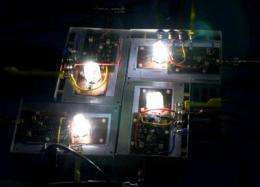January 21, 2010 report
Siemens Sets New Record for Wireless Data Transfer using White LEDs

(PhysOrg.com) -- Researchers from Siemens have broken their own record for wirelessly transmitting data over white LED light. They’ve now achieved rates of 500 megabits per second (Mbps), shattering the previous record of 200 Mbps. Wireless data transfer using light, also called Visible Light Communication (VLC), could have applications in transportation, industry, and home use.
Using an Ostar LED, one of the brightest LEDs on the market, the Siemens researchers in Munich collaborated with researchers from the Heinrich Hertz Institute in Berlin to achieve the new record. In the wireless technique, data are directly transferred by modulating, via the power supply, the amount of light emitted by the LED. The changes in brightness due to modulation are imperceptible to the human eye. On the receiving end, a photodetector converts the light signals into electrical pulses. The researchers could successfully transmit data over a distance of up to five meters at 500 Mbps; or, by combining five LEDs, they could transfer data over longer distances at rates of about 100 Mbps.
Visible Light Communication could have a variety of applications. For example, in some factory and medical environments, VLC would have the benefit of not interfering with radio-frequency devices. On roads, LED stoplights or railroad signals could be used to transmit information to cars or trains. In the home, VLC could be used to transmit data via ceiling lights to a receiver mounted on a desk located anywhere in the room. Siemens notes that the technology could also provide an addition to WLAN technology with certain advantages.
“Increasingly, wireless networks are compromised by the fact that in many buildings the three independent WLAN frequency bands are multiply occupied, which leads to collisions among the data packets,” the company explained in a press release. “In a situation like this, visible light, as a currently unused and license-free medium, offers a suitable alternative. A further advantage is that this form of data transfer is impervious to interception. Only the photodetector that is positioned directly within the light cone is able receive the data. In other words, it is impossible to ‘tap’ the data transported in the light beam.”
More information: Siemens press release
© 2010 PhysOrg.com

















